Appreciating Buddhist Art: Part Four – Ritual Tools and Symbols
PRIMITIVE - Friday, August 18, 2017By Glen Joffe
在世界艺术是不可能的and not have frequent encounters with world religion; primarily because there aren’t five religions in the world, but somewhere around 4,200! Each of those religions usually has its own rites and rituals, daily ceremonies, and celebratory special occasions; and in turn, implements and visual symbols associated with their realization. Those implements and symbols can range from everyday objects to esoteric masterworks. Sometimes they are mass produced; most often they are one-of-a-kind, their creation evidencing handwork, devotion, and rich artistic traditions.
The implements and symbols used in service to the world’s religions are not found solely in temples and edifices dedicated to worship, but in just about all places ranging from private homes to public spaces. Ceremonies, rites and rituals and the implements and symbols associated with them may vary from religion to religion. Even within any given religion or practice, the implements used and symbols accessed may be tempered by personal preference or style of worship. However, in just about every religion, specific implements and symbols are reserved for particular uses and ceremonies.
Religious implements and symbols may be harnessed for a wide variety of reasons: for example, to initiate, propitiate, bring rain, send souls to heaven, exorcise demons and evil spirits, soothe the mind and destroy the ego; and in the case of all symbols, to represent the concepts associated with the religious practice. The implements and symbols used to achieve specific objectives are loaded with symbolic meaning and may even be imbued with magical power and potency when properly activated. Even the purely symbolic can be real weapons of transformation capable of changing behavior and illuminating the mind.
Religious implements and symbols vary dramatically in terms of use, size and appearance from religion to religion. Although crossover does exist; generally speaking, any individual religion will have implements and symbols endemic to itself. It should be noted, all implements are symbols; but not all symbols are implements. Generally speaking, implements can be defined as three dimensional, functional objects. Buddhism is especially rich in the implements and symbols used in its practice. Here is a list and brief explanation of some of those implements and symbols:
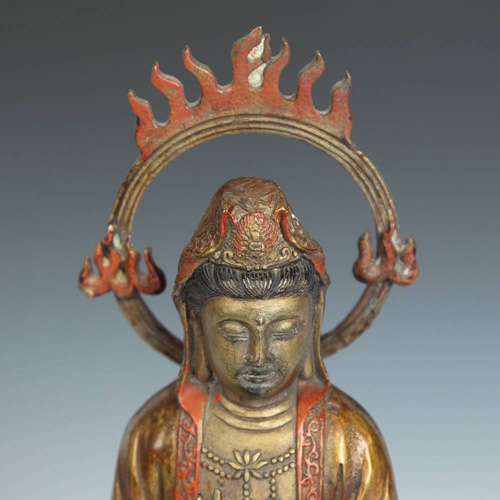 |
Seated Figure Of Quan Yin with Agni radiance; PRIMITIVE ID #A1400-261 | |
1)Agni: essentially a flame, Agni appears most often as a component in statuary, frequently as the madorla or radiance behind a deity. Agni is a cleansing tool and may be viewed as a protective tool as well.
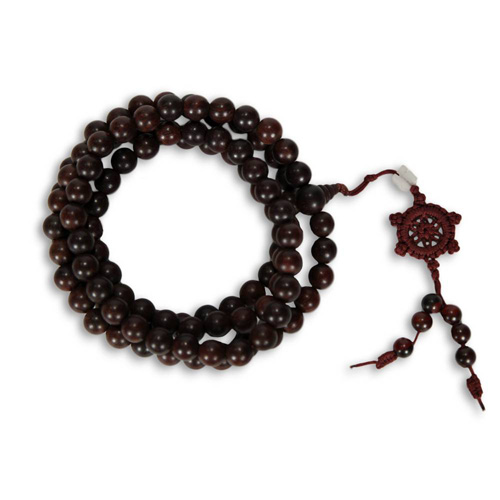 |
Mala or Ashkamala Meditation Beads;PRIMITIVE ID #J1309-216 |
|
2)Ashkamala: the Ashkamala is essentially a Buddhist rosary symbolizing the endless cycle of birth, death and rebirth. In Buddhist tradition, it is also a symbol of many deities, most notably Avolokitesvara, the deity of compassion.
3)Bumpa: a ritual vase representing the complete expanse of the universe, which may be interpreted as the endless expanse of the mind. Two kinds of Bumpa exist; the main vase and the daily vase. The main vase is usually placed in the center of a Mandala, while the daily vase resides on the Lama’s table for use during various rituals. The Bumpa or vase is also one of the Ashtamangala, or Eight Auspices of Good Fortune.
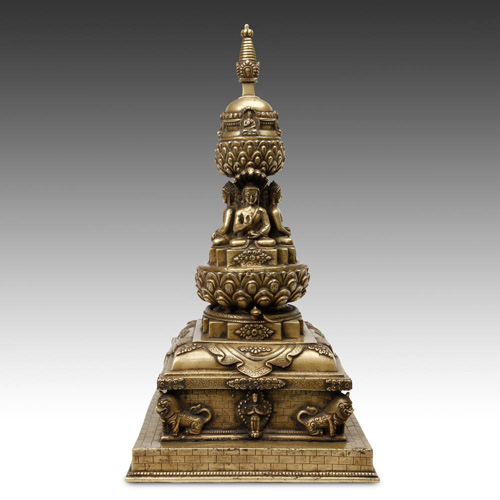 |
Chaitya or Buddhist Stupa; PRIMITIVE ID #A0702-234 | |
4)Chaitya: the Chaitya is the Buddhist Stupa, which is a representation of the Buddhist universe. Sometimes square and sometimes round with steps or levels tapering upwards, each step or level represents a heaven, the topmost part being the point of enlightenment.
5)Chakra Wheel:脉轮也称为Dharmachakra。它象征着法律的轮子或佛教佛法。它也是Ashtamangala之一,即八个好运的主持人。它有八个辐条,代表了八倍救赎的路径。
6)Chandra: Chandra is the moon and sometimes appears as a radiance behind or above a deity. It symbolizes the unity of opposites.
7)Chatra, Umbrella or Parasol:在藏传佛教中,查特拉被认为是Ashtamangala之一,或者是八个好运的主持人。它可以看作是能够保护自己的实践的设备。
8)Dadar:the Dadar is an arrow appearing frequently as an attribute of the deity Saraha, although many deities may wield it. The arrow symbolically represents the piercing of the duality concept so it can be transformed into non-duality. It is also the symbol of awareness and in some Buddhist traditions it is also called the Bana.
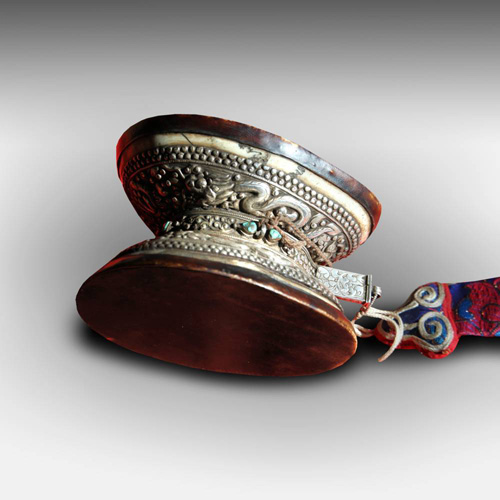 |
Damaru or Two-Headed Drum; PRIMITIVE ID #A0901-017 | |
9)Damaru:达马鲁是一个较小的两头鼓。在藏族佛教中,它由两块颅骨组成。达马鲁的象征意义和充满活力的特性是广泛的。本质上是一种乐器,它用于标记重要仪式期间的时间作为调节手段。
10)Dani:the Dani is an incense burner; essentially a metal pot used to burn incense when propitiating deities.
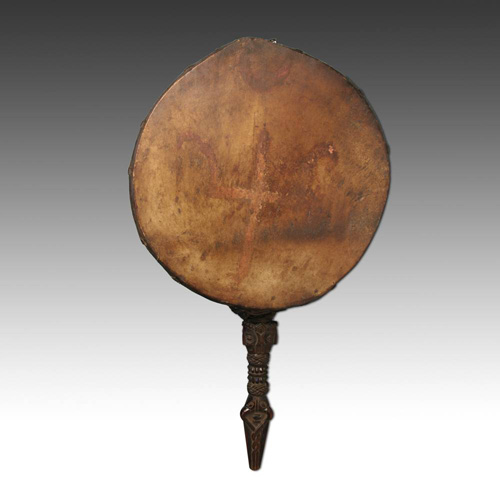 |
Dhyangro Or Shaman's Drum; PRIMITIVE ID #A020102-174 | |
11)Dhyangro:the Dhyangro is another type of drum called a frame drum. It may be single or double-headed, struck with a mallet or contain beads, stones, or balls inside so that it will sound when turned. Many Dhyangro are equipped with a handle, which frequently is fashioned like a Phurba, or ritual dagger.
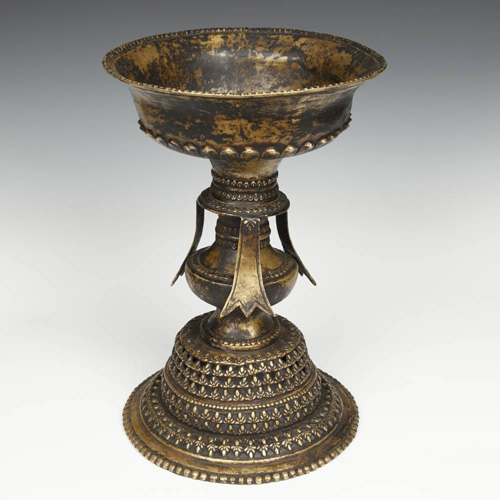 |
Dipa or Butter Lamp; PRIMITIVE ID #A1105-187 | |
12)Dipa:the Dipa is essentially a butter lamp used in the propitiation of deities.
13)Dhvaja:the Dhvaja is a banner signifying the victory of Buddhism; specifically, the victory of Buddha over the impediments to enlightenment. It is also known as the Victory Banner and is one of the Ashtamangala, or Eight Auspices of Good Fortune.
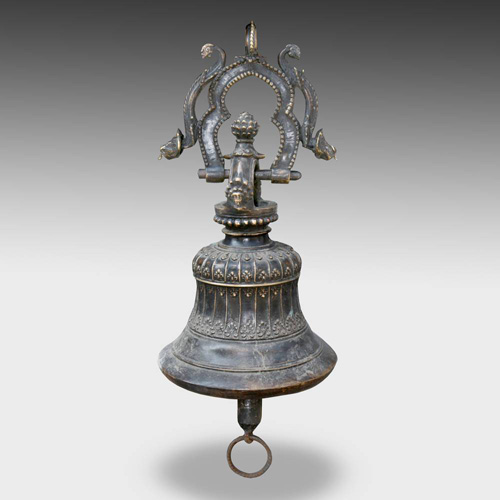 |
Large scale Ghanta or Temple Bell; PRIMITIVE ID #A0702-235 | |
14)Ghanta:the Ghanta is a ritual bell. Although the sound of the bell may be equated with the OM sound, it is the most commonly used musical instrument in all Buddhist ritual. When used in conjunction with the Dorje or Vajra in meditation it represents the sound of Buddha’s teachings and the attainment of wisdom. In tantric practice, it is said to drive away evil spirits. Its sound can also represent the union of male and female principles, or the creation of non-duality.
15)Kalasa:Kalasa是船只,基本上是一个可能会盖好的碗。它象征着永生,因为据说它拥有生命的长生不老药。
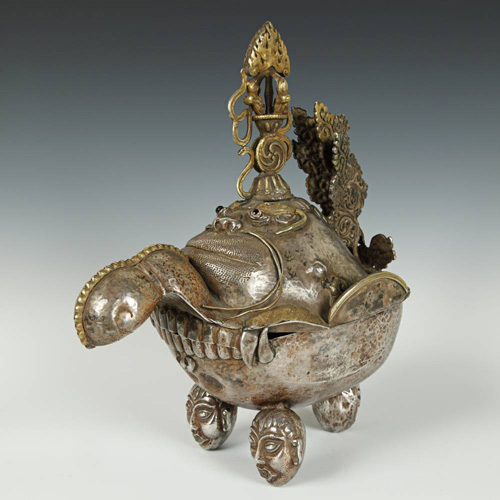 |
Kapala Or Ritual Skull Cup; PRIMITIVE ID #A0506-1112 | |
16)Kapala:卡帕拉也称为颅骨杯。通常是由人类头骨制成的,也可以由贵金属形成,并用珠宝和宝石包裹。据说可以持有血液并象征物理宇宙的溶解。它也是各种神灵和特定实践效力的象征。
17)Kartika:卡蒂卡(Kartika)是一把小刀,象征着世俗纽带的遣散。
18)Khadga:a sword. The Khadga is a symbol of enlightenment. It is wielded to destroy ignorance and sever the bonds of worldly attachment. Frequently, it has flames or Agni radiating from the end, which further illuminate and ultimately destroy ignorance.
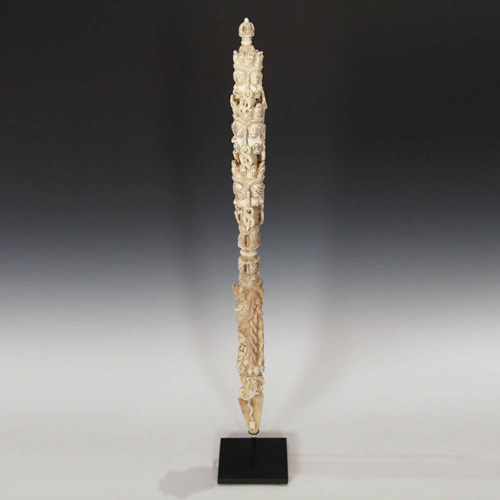 |
Khatavanga; PRIMITIVE ID #A1406-175 | |
19)Khartawanga:the Khartawanga is also known as a Khatavanga. It is a form of a club, which can be made of bone, wood, or metal. It symbolizes the smashing of impediments to enlightenment.
20)Khata:卡塔(Khata)是藏族佛教经常使用的礼仪围巾。它象征着纯洁和同情心,并在多次仪式和多次仪式上佩戴或给予。
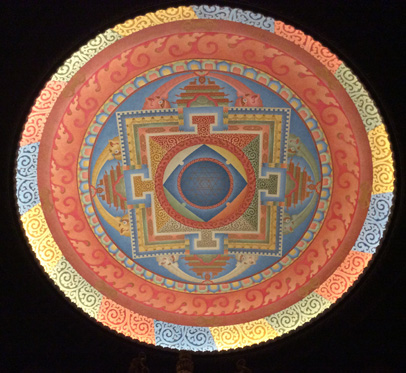 |
Mandala of creativity as seen at PRIMITIVE |
|
21)Mandala:the word Mandala literally meanscirclein Sanskrit. A visual aid that can be thought of as architecture with four cardinal points relating to the four directions serving as entrances and exits, it serves as a point of concentration in meditation. The Mandala is the graphic representation of the process leading to the attainment of insights. Those insights can also culminate in the activation of supernatural forces.
22)Matsya:the Matsya are a pair of fish. One of the Ashtamangala, or Eight Auspices of Good Fortune, they symbolize beings rescued from the ocean of earthly misery called Samsara in Buddhism.
23)Naga:the Naga are serpents and when propitiated can bring rain. They are also considered the protectors of the Dharma, or laws of Buddhism.
24)Padma:the Padma is a lotus flower representing purity and self-realization. It is also one of the Ashtamangala or Eight Auspices of Good Fortune.
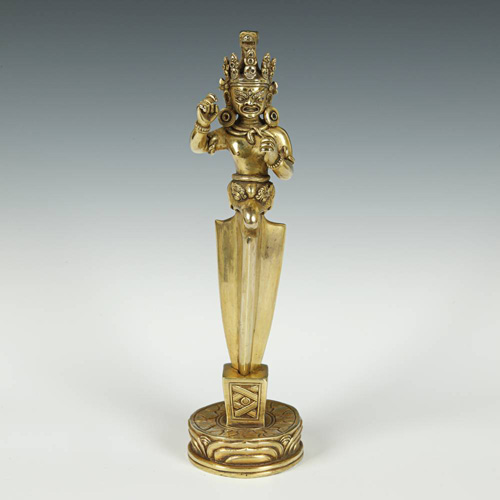 |
Standing Phurba; PRIMITIVE ID #A1001-641 | |
25)Phurba:also known as a Kila, ritual dagger or magic dart, the Phurba is used to pin heaven and earth to slay or dissolve ignorance, hatred, aggression, intolerance, insensitivity, etc.
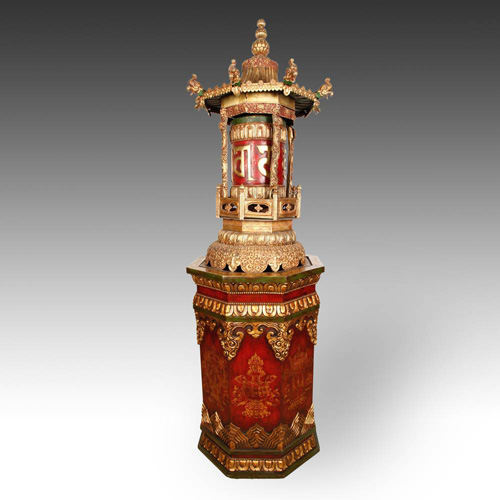 |
大型手动祈祷轮;原始ID#A0901-055 | |
26)Prayer Wheel:祈祷轮是一种佛教乐器,由带有加权延伸器或特纳的手柄上的圆柱体组成。圆柱体可能充满咒语或可重复的祈祷。轮子的每个转弯都代表着内部祈祷的朗诵。祈祷轮不一定是手工固定的,可以在没有特纳的帮助下手动转动。它们也可能是大小的,自由站立或嵌入墙壁。
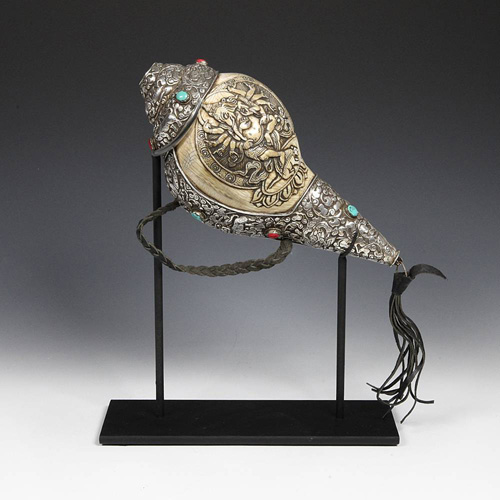 |
Sankha或Conch Shell小号;原始ID#A1702-004 | |
27)Sankha:桑卡是海螺外壳。用作小号,它代表了佛法的刺耳声音从深深的无知中呼唤从业者,因此他们将为自己的利益和他人的利益而努力。该海螺被认为是原始的号角小号,也是Ashtamangala之一,即八个好运的主持人。
28)Shrivasta or Endless Knot:Shrivasta也被称为无尽的结或爱结。它是万物最终统一的象征,也是爱,智慧和同情心的交织。它是Ashtamangala之一,或八个好运的主持人。
29)卍:in Buddhism the Swastika symbolizes the eternal aspects of the Dharma.
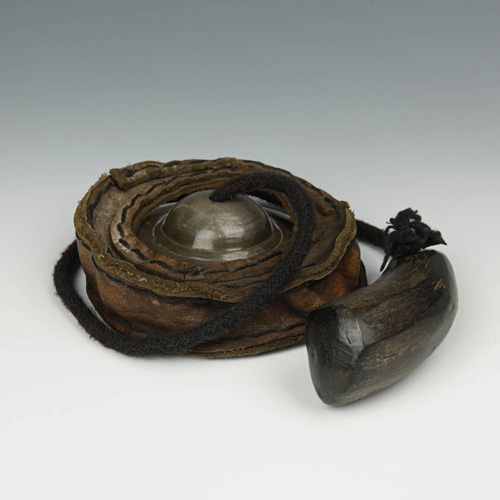 |
Single Tingsha with horn knocker; PRIMITIVE ID #A1108-033 | |
30)Tingsha:the Tingsha are small cymbals usually presented in pairs although they may also be presented singly with a knocker attached. When struck together or hit by the knocker a harmonious long tone is produced, the sound itself said to be an offering of harmony.
31)UTPALA:the Utpala is a half-closed lotus representing the unfolding of self-realization.
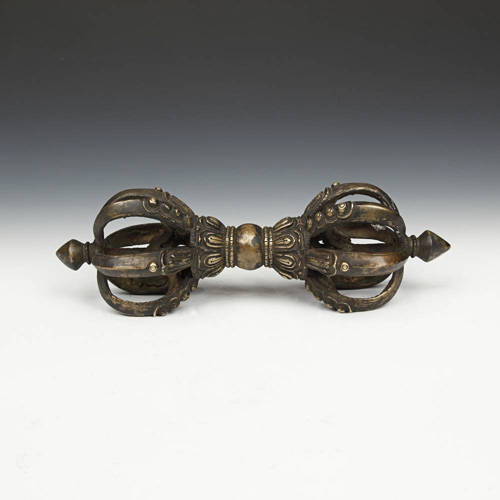 |
Vajra; PRIMITIVE ID #A1105-215 | |
32)Vajra:金仙女是一个像俱乐部一样的俱乐部,在球形中心举行了两个带肋的球形头会议。在藏族中,它被称为Dorje。瓦杰拉(Vajra)是梵文(Sanskrit)的雷电。它也被称为坚不可摧的钻石。无论它被称为什么,它都是为了摧毁所有类型的无知。它也可以显示为两个杂货店,然后被称为双瓦尔(Double Vajra)或双dorje。与Ghanta结合使用,它代表了启蒙的道路。